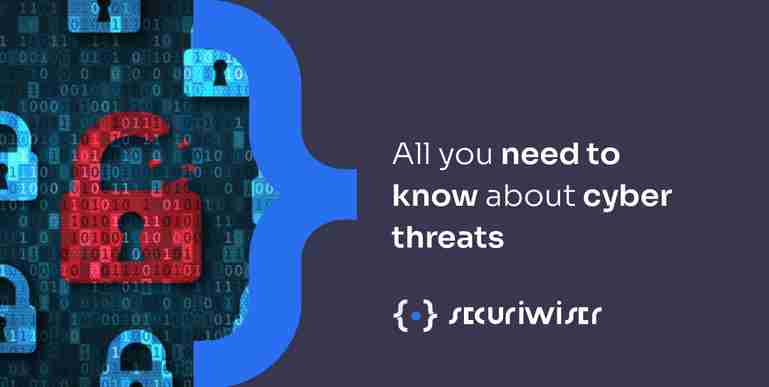All you need to know about cyber threats
Blog / All you need to know about cyber threats
3 MIN READ

A cyber or cybersecurity threat is a harmful act that aims to steal data, or otherwise negatively affect digital life. Computer viruses, data breaches, Denial of Service (DoS) assaults, as well as other attack vectors are examples of cyber dangers.
A cyber assault that is aimed at gaining unauthorized access, damaging, disrupting, or stealing information (or any other type of sensitive data) is referred to as a cyber threat. Individuals inside a company as well as outsiders can pose a cyber danger.
Where do cyber threats originate from?
Threat actors are responsible for a range of growing cyber threats that include propaganda, website defacement, espionage, disruption of critical infrastructure, even loss of life, according to national cyber warfare plans. Government-sponsored programs are becoming more common and represent advanced risks. They can successfully utilize technology and techniques against the most challenging targets such as classified networks or essential infrastructure like electricity grids, gas control valves, etc. These hostile nation-states pose the greatest risk to many nations as well as countries.
Hacktivists have started to use cyberattacks as a way of promoting their political agenda or bring out social change. The actions of hacktivists cover a wide spectrum of political goals as well as causes. The majority of hacktivist organizations are more interested in spreading their propaganda rather than causing infrastructure or service disruption. Instead of causing maximum harm to an organization, their purpose is to assist their political objective.
Insiders that are dissatisfied can sometimes turn into cybercriminals. Since they already have access to the data, intruders don't always require a high level of computer competence to reveal sensitive material. Third-party suppliers and workers also pose internal dangers since they may inadvertently inject viruses into systems or log into a protected S3 bucket to obtain all your data and distribute them online.
What are the different types of cyber threats?
Malware is computer software designed to cause harm to a device or network like damaging data or gaining control of a system.
Spyware is a type of malware that lurks on a device and sends factual data to its host, allowing them to encrypt files, such as bank account numbers and other user credentials.
Phishing occurs when cybercriminals trick someone by posing as a real company and try to get them to reveal personally identifiable information (e.g banking and credit card details, and passwords).
Distributed denial of service attacks attempt to disrupt a computer system by overloading it with unnecessary demands, causing the system to become overburdened and preventing genuine requests from being performed.
Ransomware is a sort of software that prevents users from accessing a computer network or data unless they pay a ransom.
A trojan infects your computer and opens a backdoor, allowing an attacker to take control of your machine or access private data.
A wiper attack is a type of malware that aims to erase the hard disk of the infected machine.
Data manipulation is a type of cyberattack that tries to manipulate data rather than steal it, making it more difficult for an organisation to function normally.
Data destruction refers to the deletion of data.
Man-in-the-middle attack is a type of eavesdropping attack where the offender places himself in a conversation between the user and the application.
Malvertising is using online advertising to spread malware.
Rogue software is malware that acts like legitimate software.
Protecting against cyber threats
Every firm faces cybersecurity dangers, which aren't always under the direct authority of your IT security personnel. Globalization, cloud computing, and outsourcing have created a considerably bigger attack vector than in the past. Third-party, as well as fourth-party risks, are increasing, making third-party risk management, vendor risk management, including cybersecurity risk management all more critical to lower the risk of third-party data breaches.s.
When you combine this with the fact that company executives make technology-related risk choices on a daily basis in every department without even realizing it, you have a recipe for disaster. Consider this scenario: your IT team releases a new email feature for your software to send promotional emails to customers who sign up for a free trial. But the newly released feature has weak security procedures in place. As a result, you risk not only exposing your customers' personal identifying information (PII), but as a company, you may inadvertently help cybercriminals commit identity theft in the process. Thus, security measures cannot be left to your IT team only. It must be a company-wide endeavour.
When cyber threat information is collected, assessed, and analysed, it produces cyber threat intelligence. Cyber threat information gives you a deeper knowledge of cyber risks and helps you to quickly and accurately detect commonalities and differences among different types of cyberattacks.
The intelligence cycle is a cyclical procedure for developing cyber threat intelligence. Data gathering is planned, implemented, but also assessed throughout the intelligence cycle to create a report, which is subsequently disseminated and re-evaluated in light of new evidence. During this process, you may discover gaps, unresolved issues, or even put in place new requirements.
Cyber threat information, when used correctly, gives insights into cyber threats and encourages a faster, more targeted reaction. It may help decision-makers assess acceptable cybersecurity risks, controls, and budget restrictions in terms of equipment and people, as well as support incident response and post-event response operations.
Improve your cybersecurity posture with Securiwiser
Securiwiser can help you safeguard your company from data breaches, find all of your data leaks, as well as keep track of all of your vendors' security postures. Click here to get an immediate security score!
Previous Article
Third Party Risk Management FrameworkHow secure is
your school?
Blog categories
How secure is
your school?